Wagner cast iron cookware is regarded by many as some of the finest examples of 19th and 20th century cast iron. Much of the cast iron is over 100 years old and still usable today. These antique pans are sought-after by enthusiasts who prefer vintage cast iron to newer pans. But identifying and dating these old Wagner Ware Sidney -o-pans can be tricky.
So, with this article, I hope to help you and other proud owners identify and give an estimate of the age of your cookware. You can also learn the history of your cast iron, which the Wagner Manufacturing Company manufactured.
Table Of Contents
- Wagner cast iron. “Why is it so collectible?”
- Learn the history of the Wagner Manufacturing Company.
- Where you can buy Wagner cast iron.
- Considerations when purchasing Wagner cast iron cookware.
- You can identify and date antique Wagner cast iron using trademarks and logos.
- Final thoughts on collecting vintage Wagner Ware cast iron.
But first, here is a quick look at the Wagner Manufacturing Company.
Identify And Date Your Wagner Cast Iron Skillets Using Logos. Also, Learn The Fascinating History Of Wagner Manufacturing.
Background To Wagner Manufacturing Cast Iron.
Founders | Milton M. Wagner and Bernard P. Wagner |
Operational Dates | The foundry in Sidney operated from 1891-1959 |
Located | The Wagner Manufacturing foundry was in Sidney, Shelby County, Ohio. |
Product Line | Wagner was one of the largest American manufacturers of cast iron products in the 20th century. Their product line included skillets, kettles, bean pots, Dutch Ovens, roasters, fruit presses, scoops, broilers, Griddles, waffle irons, muffin pans, and cornbread pans. The company also had a range of aluminum cookware. |
Wagner Brands | Wagner labeled their cookware under the following names: Wagner, Wagner Ware Sidney -o-, Wagner Ware, National, Long Life, Magnalite, Wardway, and Ward’s Cast Iron. |
Signature Products | Wagner is best known for the Sidney -O- range of skillets and Dutch Ovens. |
Reason For Closure | The reason for the closure of the foundry came from two fronts. Firstly, the Wagner family sold their interests in the company in 1953 to the Randell Company. Secondly, the company struggled financially because of a drop in sales. The decline in sales was due to two World Wars, the Great Depression, the development of new cookware materials, and the increase of lower-priced imports from Asia |
Wagner After Buyout (Non-Collectible) | In 1957, the Randall Company purchased long-term competitor Griswold from McGraw Edison. The Randall Company sold the cast iron businesses to Textron Corp in 1959. General Housewares Corporation bought Textron in 1969. In 1994, the production of Wagner Ware ended. |
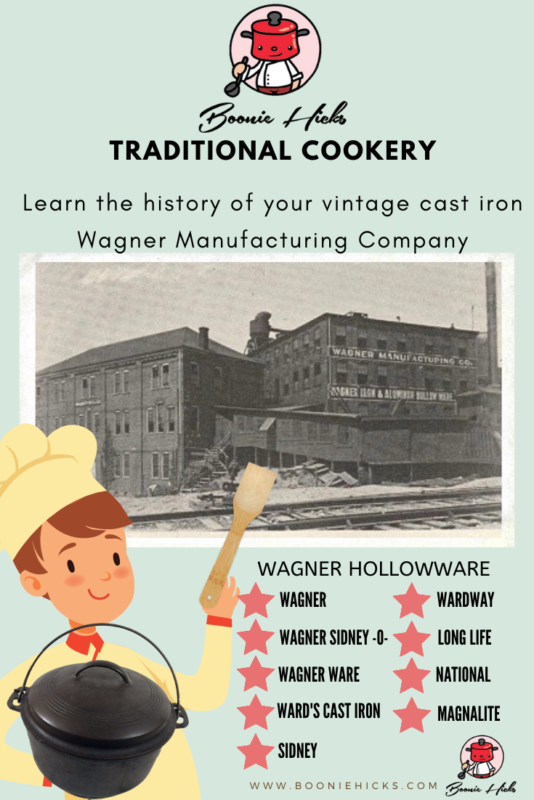
Why Is Wagner Cast Iron Collectible?
Super Smooth Cooking Surface.
Wagner cast iron is highly collectible. Like most antique cast iron, Wagner manufactured high-quality cookware for their entire range of cast iron products.
Unlike Wapak cast iron ironware, it often has characteristic casting flaws. Wagner cast iron tends to have a few casting flaws, resulting in very smooth cookware on both the interior and exterior of the cookware.
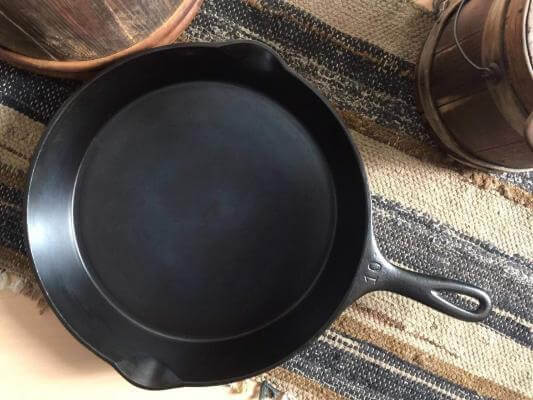
Focus On Quality
Imagine that workers would have worked on individual pieces of ironware. It was machined to smooth the interior and exterior of each pan. You can only see this level of detail in high-end cast iron cookware such as Le Creuset and Staub.
Today, Le Creuset and Staub benefit from combining traditional and modern manufacturing methods. However, the workers at Wagner could make cast iron cookware without casting flaws or bubbles. Must have taken great skill and attention to detail.
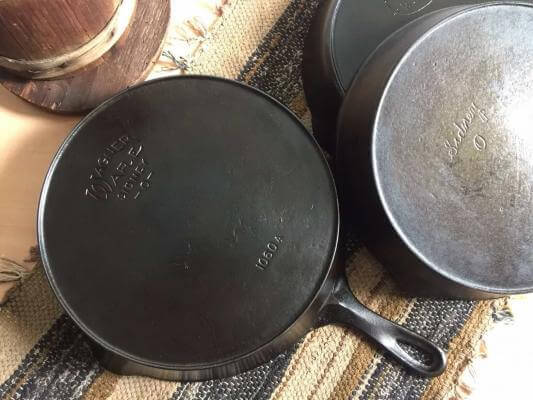
Wagner Made A Wide Range Of Cast Iron Cookware.
You can’t go wrong with an old Wagner cast iron skillet. It will serve you well for years, and they’re great fun. However, you may want to consider a Wagner Dutch oven. They are super smooth, and just like the skillets, they are reasonably priced. You can also buy cast iron muffin pans, which can be pretty cheap. But watch out for shipping costs that can increase the overall price drastically. Some of Wagner cast-iron cookware range includes:
- Dutch ovens
- Griddles
- Gem pans
- Waffle irons
- Skillets
You can even collect Wagner cast iron cornbread pans that look like corn cobs. Wagner Manufacturing also produced aluminum cookware, which must have seemed revolutionary.
Collect Your Favorite Logo.
If you want a vintage skillet, then Wagner skillets are a great choice. You can choose from sixteen different logos and trademarks or markings. I like pans with heat rings, while others may prefer a pan with a smooth base.
I think this wide selection makes Wagner cookware more collectible than other manufacturers, such as Vollrath and Martin Stove and Range, which manufacture a limited range of products.
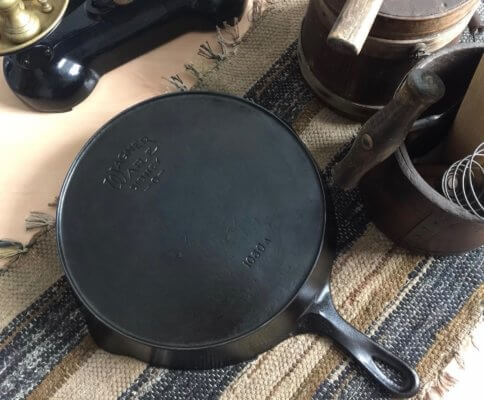
Wagner Manufacturing Company Focused On Quality Over Quantity.
Quality was a focus from the very start for Wagner Manufacturing Company. They even advertised this selling point to consumers. Old advertisements read;
We do not strive to manufacture hollowware as cheaply as possible but as well as it can be made. We cannot afford to put on the market ware that will not sustain our reputation. The name Wagner is on the bottom of each piece of ware.
Wagner Manufacturing Company History
Founders And Foundry
Who Founded Wagner Manufacturing? | Wagner Manufacturing Company was founded in 1891 by Milton M. and Bernard P. Wagner. However, two more Wagner brothers, Louis and William Wagner, joined the company in the following years. Another key player in the foundation of the company was R. Bingham. Bingham previously worked at Marion Stove Company and the Sidney Manufacturing Company. |
Where Was Wagner Cast Iron And Wagner Ware Made? | The company had its ironworks in Sidney, Shelby County, Ohio. Early cookware from Wagner Manufacturing had a simple Wagner marking on the back of the ironware. Wagner included Sidney O. in their cookware around 1895. The term Wagner Ware first appeared in the logo in the 1920s. |
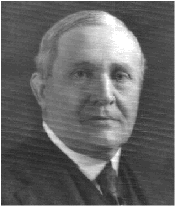
The Wagner Product Line Added Nickel Plating, Aluminum, And Magnalite.
Nickel-Plated Cast Iron | To complement their cast iron range, Wagner added a nickel-plated range. Unlike cast iron and copper pots, nickel plating does not react to acidic foods such as tomatoes, which can taint food. It’s easy to look past the development of nickel-plating. But, in the 19th century, bonding two metals together would have required much metal casting expertise. |
Aluminum Cookware | Along with nickel-plated cast iron, the Wagner brothers in 1894 manufactured a line of aluminum cookware, and Wagner Manufacturing was one of the first companies to do so. |
| Aluminum Cookware Exported To Europe | By 1913, Wagner cast iron and aluminum products were selling in Europe. |
| Magnalite | In the 1930s, Wagner manufactured a cookware line with a patented aluminum alloy called Magnalite. |
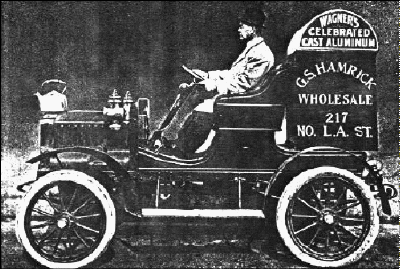
Wagner Manufacturing Buys Their Sidney Competition.
| Wagner Bought Sidney Hollowware Company. | In 1897, Wagner bought the Sidney-based competitor Sidney Hollow Ware Co. from the founder and owner Phillip Smith. Sidney Hollow Ware made high-quality cast iron cookware that was extremely light and smooth. Sidney Hollow Ware Co. was also an early adopter of nickel-plating cast iron. |
Why Did Wagner Buy Sidney Hollow Ware Company? | It was a brilliant idea to buy the Sidney Hollow Ware Company. After all, Wagner Manufacturing and Sidney competed in the same city and made comparable products. However, it was common knowledge that Smith made a tidy profit from his original investment in the foundry. To run the Sidney Foundry, William H. Wagner joined the family business to oversee the operation. |
Wagner Sold Sidney Hollow Ware Back To Phillip Smith. | In 1903, Wagner Manufacturing sold the Sidney Hollow Ware Company to the founder, Phillip Smith. Sadly, Phillip Smith did not reopen the foundry due to health reasons. |
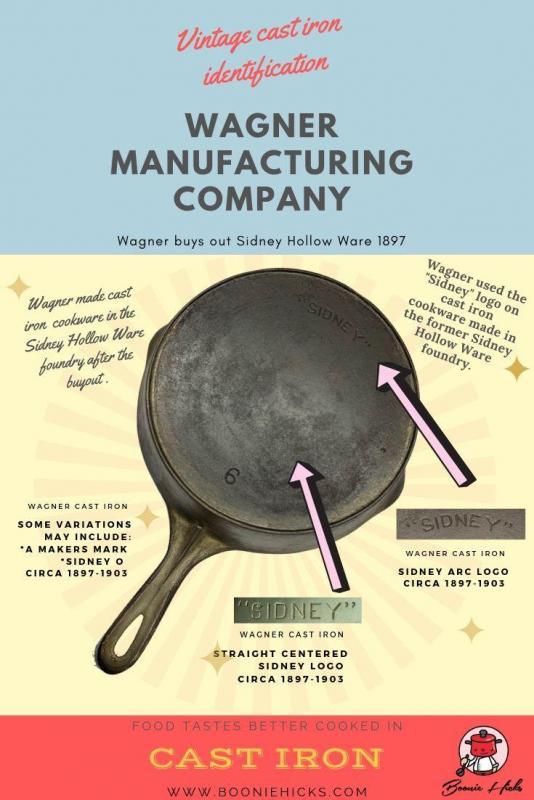
Wagner Introduced A New Product Line To Stop A Decline In Sales.
| The Great Depression (Magnalite) | I have to take my hats off to Wagner because they introduced a new product line called Magnalite in one of the deepest recessions the world has ever seen. Wagner Manufacturing was steadfast in making only quality products. For this reason, the cookware is collected and highly usable. |
| The Sales Decline | Wagner introduced Magnalite to stop falling sales at Wagner Manufacturing; it was not due to their product range. Magnalite was hugely popular, but it could not offset the effect of the worldwide recession. From 1929-1941, the US was in the grips of what we now call the Great Depression. Therefore, it was not only Wagner. However, many foundries struggled financially to survive. Many didn’t. |
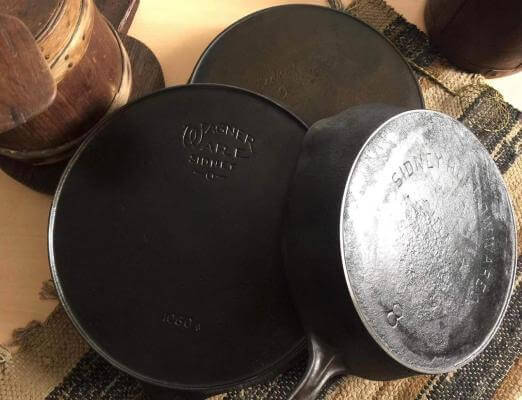
The Family Sells Their Interest In The Foundry.
Wagner Family Sells The Company To Randall Corp. | Wagner Manufacturing Co. lasted longer than many foundries. However, in 1952, Wagner was sold to the Randall Company. Unbelievably, the Randall Company was a car parts manufacturer. |
Textron Buys Randall | In 1959, another business called Tetron bought Wagner. Textron also purchases Griswold Manufacturing Company. At this date, cast iron enthusiasts consider this the end of Wagner Ware production. Wagner cast iron pans made after this date are considered not collectible. |
General House Wares | General Housewares Corporation in 1969 bought the rights of Griswold and Wagner. |
Is Wagner Ware Still Made? | With the world rediscovering cast iron cookware, will we see Wagner Ware skillets manufactured again? General Houses Ware stopped the manufacture of Wagner Ware in 1994. However, there is a glimmer of hope for Wagner Ware. In 2014, American Culinary bought both the Wagner and Griswold trademarks. So, fingers crossed, cast-iron fans may one day decide to manufacture Wagner cast iron again. |
Where Can You Get Your Hands On Some Wagner Ware?
- Grandparents (best deal and great to keep your heritage in the family).
- Antique stores (check online to compare the store price).
- Garage sales (rescue those poor skillets from the tip).
- Flea markets (search the markets for hidden gems).
- Online (largest selection available; however, asking prices can vary greatly.
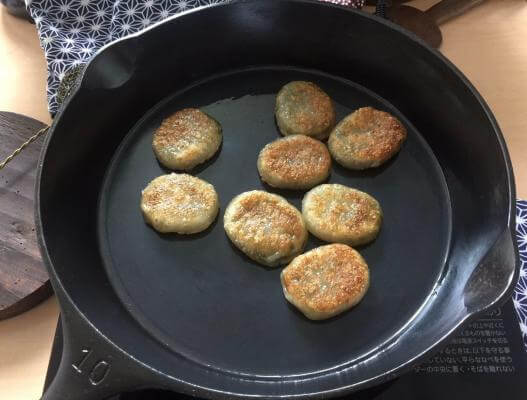
Buying Considerations Before You Buy Antique Wagner Ware
There Is Plenty Of Wagner Cast Iron Around, So Take Your Time.
There is no shortage of Wagner cast iron. Wagner had a large percentage of the cookware market back in its heyday. And plenty of fantastic Wagner skillets and Dutch ovens are in excellent condition.
What Size Skillet Or Dutch Oven Suits Your Needs?
The first thing you may want to think about is the size you need. There are often plenty of #8 skillets around. This size seems to be the most common for Wagner skillets and other vintage cast iron manufacturers, such as Favorite Piqua.
Inspect Carefully Since A Lot Of Wagner Ware Is Nickel-Plated.
Check the cookware carefully. The Wagner Manufacturing Company was an early adopter of nickel plating. However, most of Wagner cookware is unplated iron. Heavy seasoning may hide nickel plating. Nickel-plated can wear off or be patchy in places. Take a close look before purchasing.
Would You Like A Wagner Ware Skillet With A Smooth Bottom Or Heat Ring?
Do you want a pan with a smooth bottom or one with a heat ring? The older Wagner Ware skillets will have a heat ring, while the later-made pans have a smooth, flat base. It is a personal preference. I tend to like the older skillets with heat rings. They have more character, but the smooth-bottom Wagner cookware tends to be a little cheaper. And they are great cooking pans, too.
Does The Cookware Sit Flat?
As with all antique cast iron, asking the seller if the pan sits flat could be a good idea. A lever base is practical if cooking on a flat surface such as induction or glass.
Learn To Date And Identify Your Wagner Cast Iron Using Logos And Markings.
Although I’ve researched carefully, please only use the dates as an approximation.
Wagner cast iron cookware, to my knowledge, has sixteen known logos, brands, or markings. These include:
Straight Wagner Logo 1890s-1915
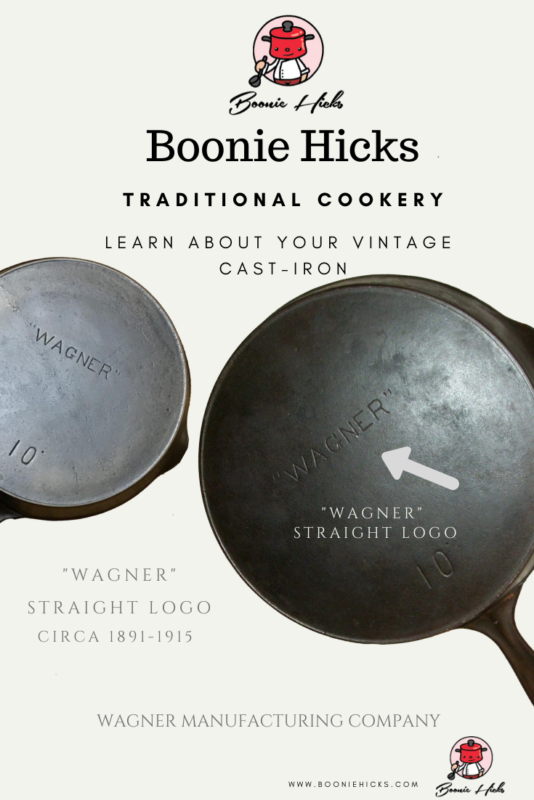
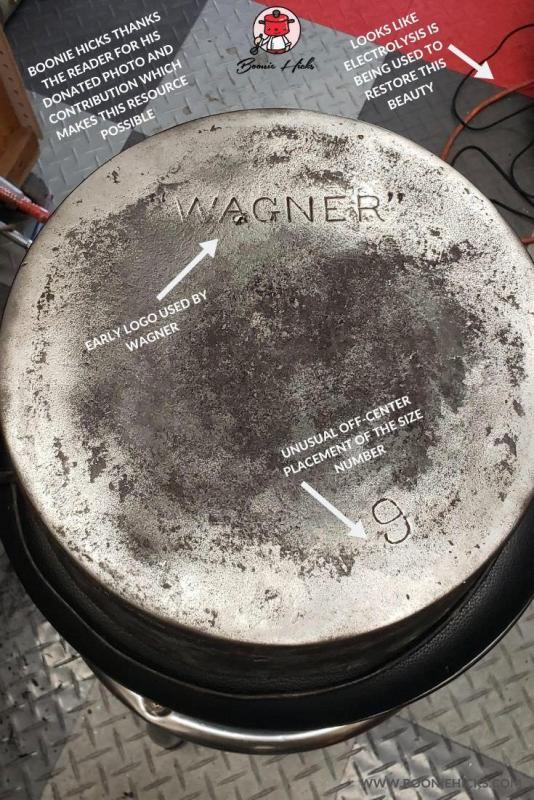
Wagner Arc Logo 1891-1910
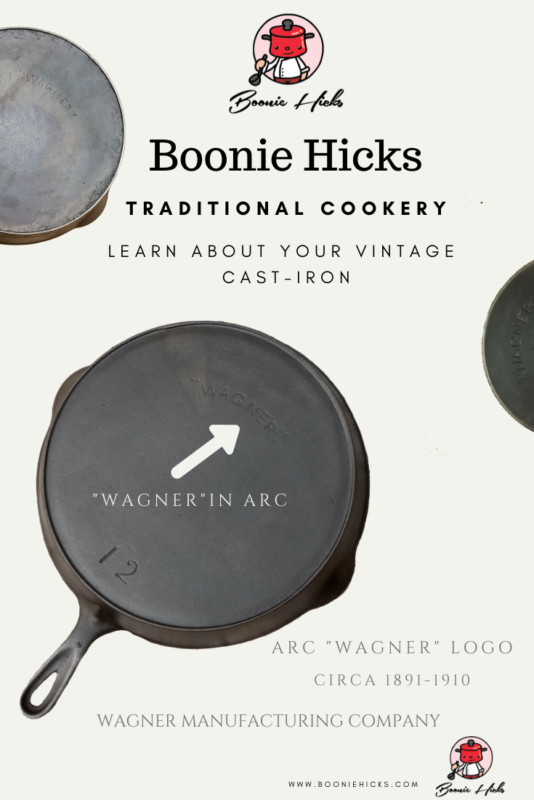

Double Arc Wagner Sidney O 1895-1915
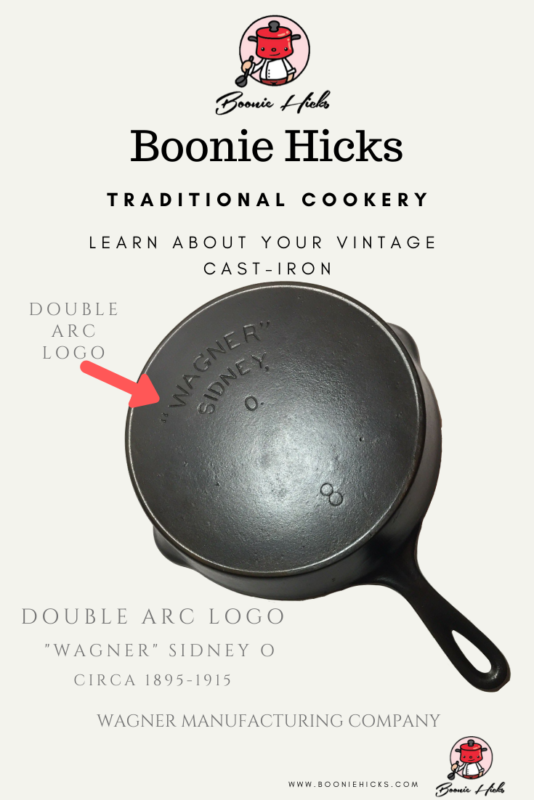
Sidney Arc logo Circa 1897-1903.
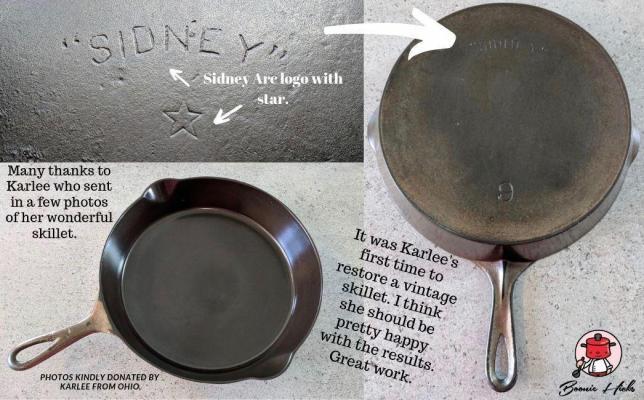
Straight Sidney Logo Circa 1897-1903.
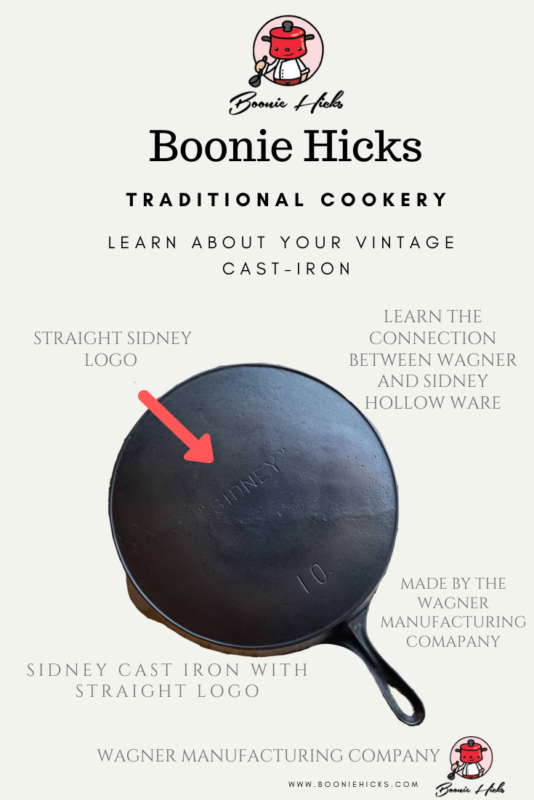
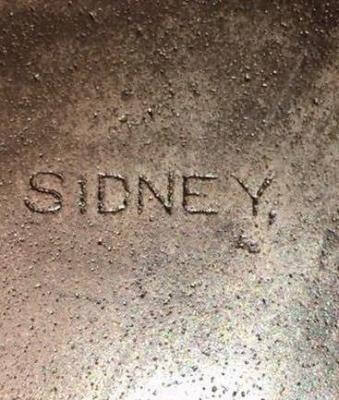
Straight Wagner Sidney O. (Centered.) 1910-1915
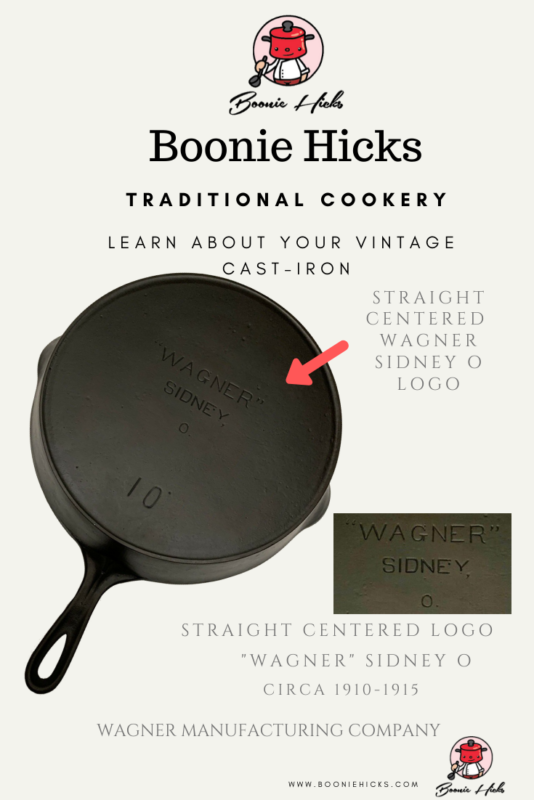
Wagner Sidney O. Wagner Slightly Arced While The Sidney Lettering Is Straight. Circa 1915-1920s
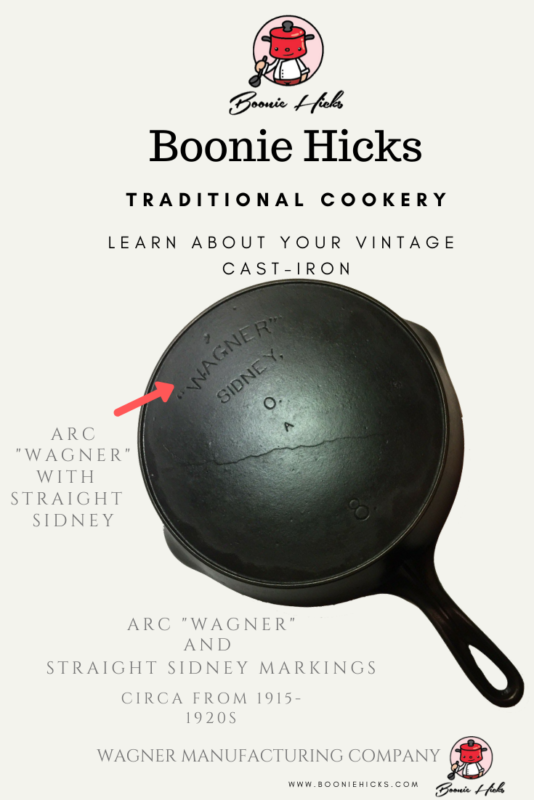
First Wagner Ware Sidney O. With Arc Wagner And Straight Ware And Sidney. Circa 1920s.
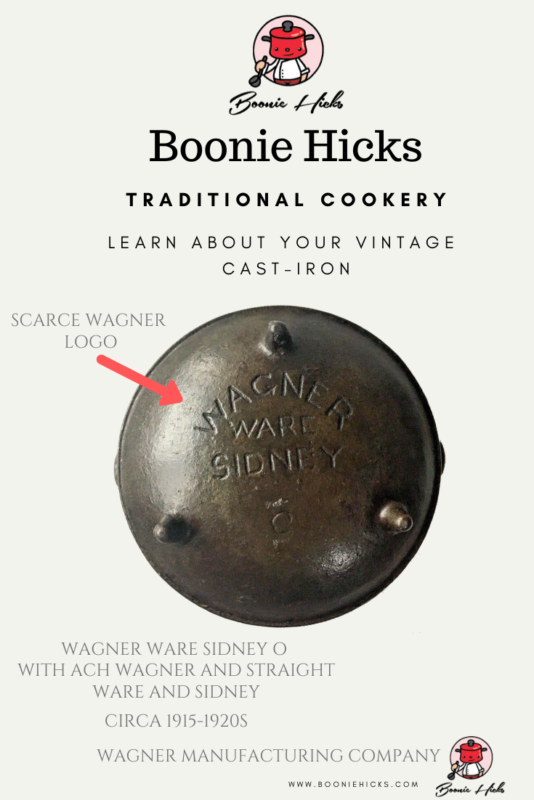
Stylized Wagner Ware Sidney O. for regular skillets. Circa 1920-1924 with heat ring and single-digit size number. 1924-1935 with a heat ring and a four-digit pattern number. Around 1935-1959, for skillets with no heat ring.
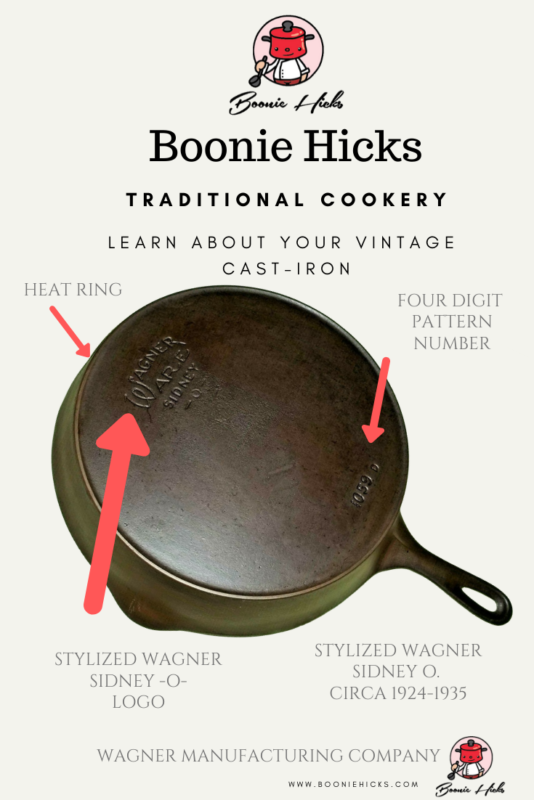
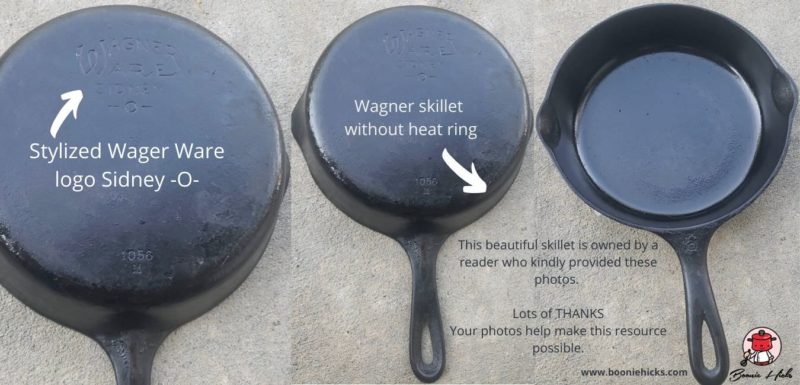
Centralized Stylized Wagner Sidney O. 1924-1935 With Heat Ring.
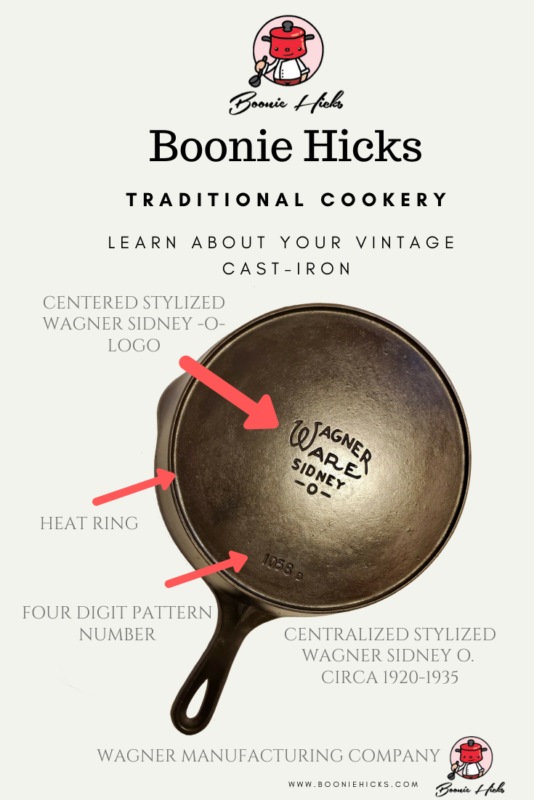
Pie Logo 1924-1934. However, Manufacturing Dates Are Uncertain.
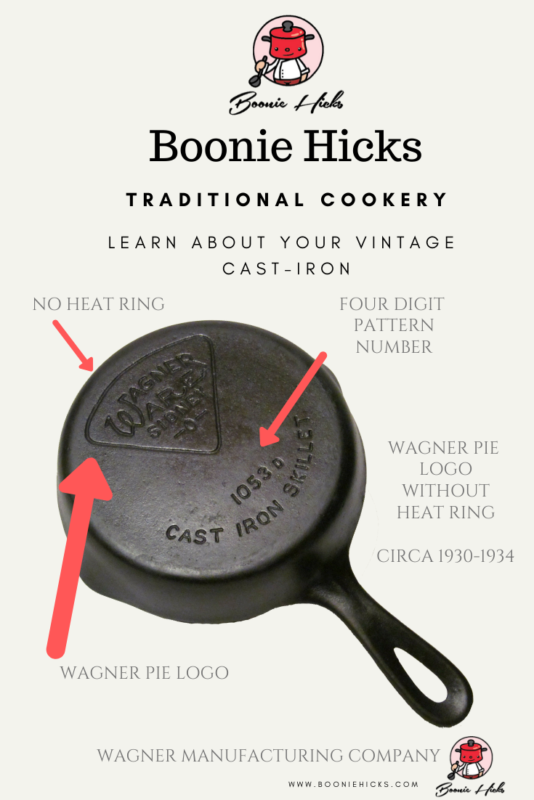
National Cast Iron Dates Between 1914 and 1940s
There are several different versions of cast iron with the National marking. Wanger marketed the Nation brand as entry-level cookware for budget-conscious consumers. Wagner made the National line circa 1914 to 1940.
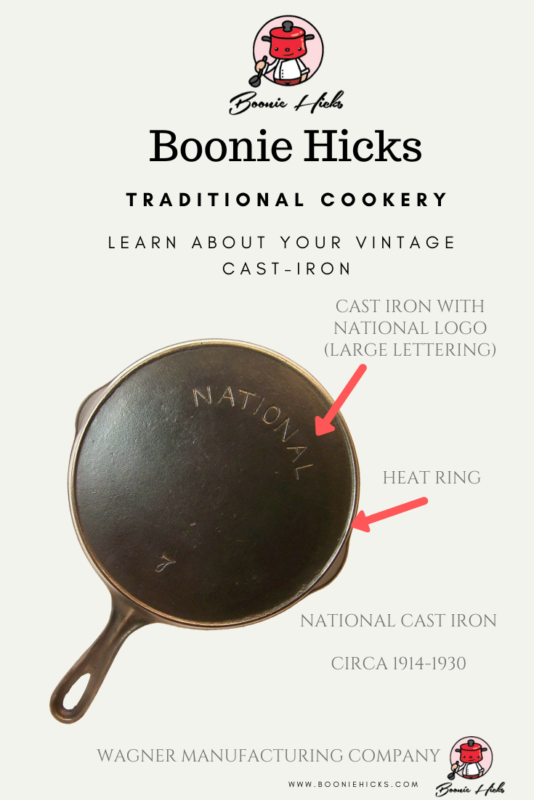
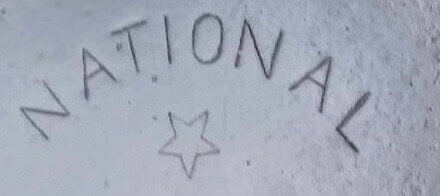
Long Life Logo 1930s.
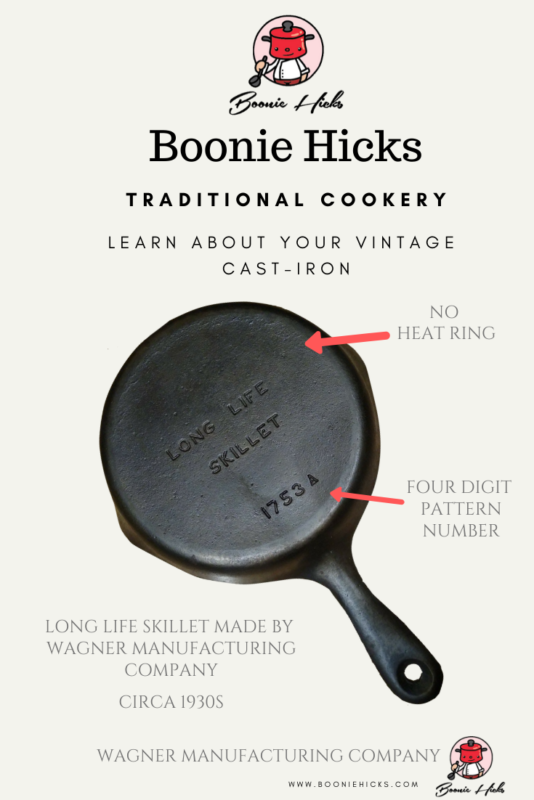
Wardway and Montgomery Ward. The Montgomery Ward Department store contracted Wagner Manufacturing Company to produce an in-store label. Circa the 1930s.
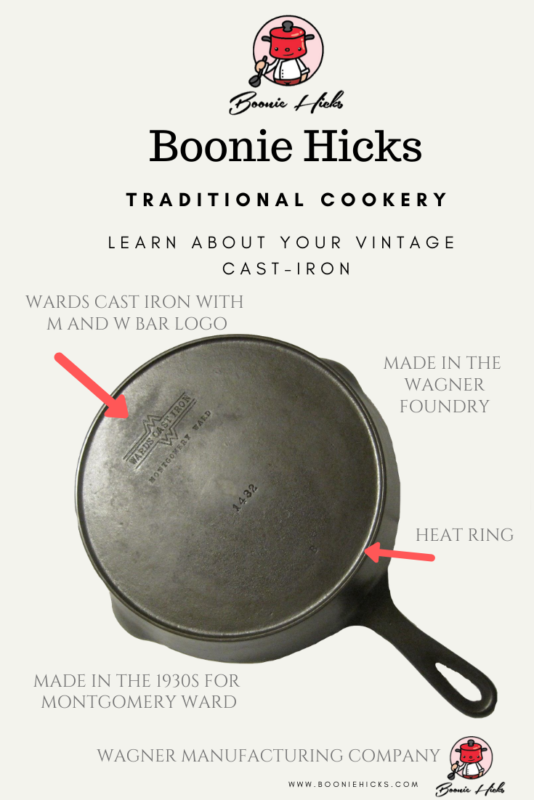
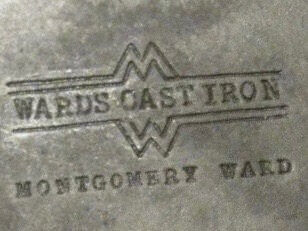
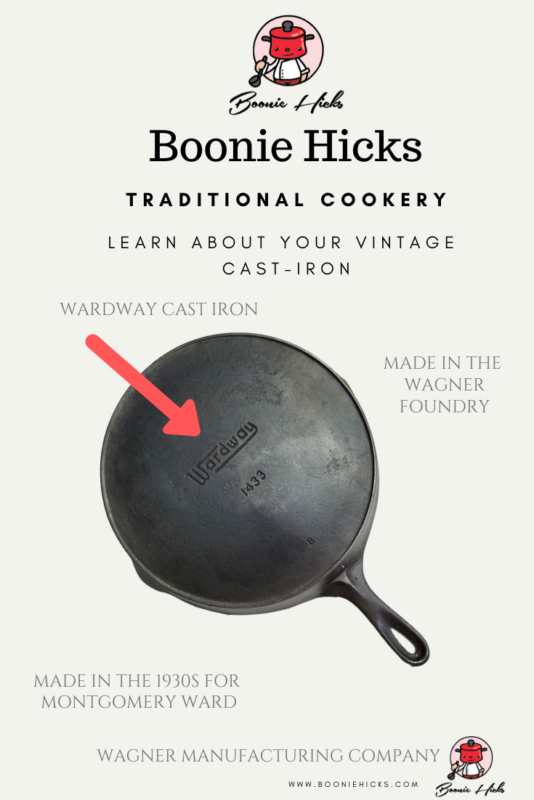
Final Thoughts On Wagner Cast Iron.
Fortunately, Wagner cast iron is more straightforward to date than other foundries of the time. Wagner Ware also has a huge collector base, so dates are well documented. The Cast Iron Collector is a valuable online resource for enthusiasts. Also, there are Facebook groups where you can share your love of cast iron cookware.
The Wagner Manufacturing Company was known for quality over quantity. Therefore, it has a good reputation for making trustworthy products.
Today, collectors and enthusiasts seek out Wagner cookware. However, you don’t need to be a collector to enjoy vintage cast iron. Here are six reasons why Wagner Ware is excellent ironware.
Although many cast iron enthusiasts look for Wagner-made skillets. But you’re not limited there. Wagner Manufactures a wide selection of cast iron cookware. You may find yourself becoming interested in:
- muffin pans
- Dutch ovens
- Scotch bowls
Since Wagner made some of the finest cast iron of the 19th and 20th centuries, Wagner ironware is still sought-after by cast-iron fans and hobbyists alike.

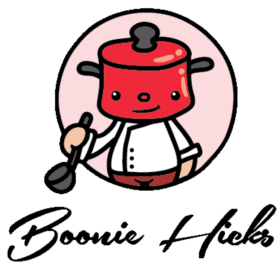
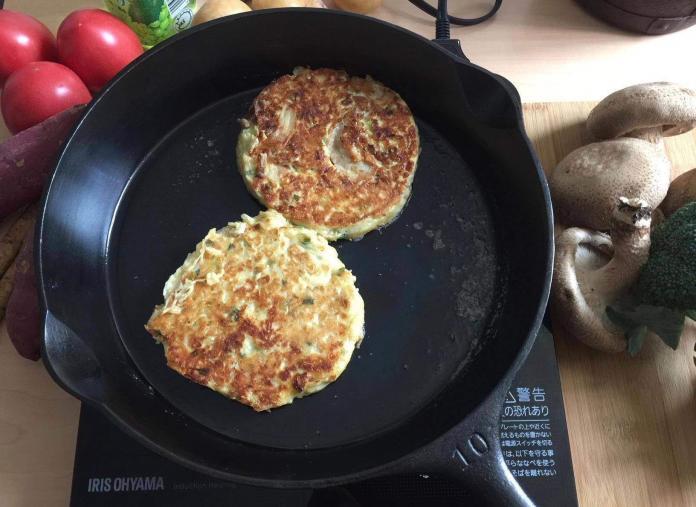
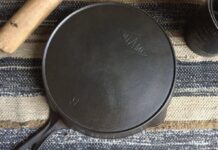
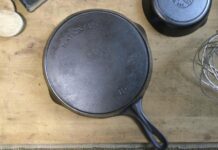
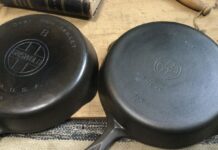



Just curious. I just picked up a very corroded Wagner 9A from around 1915-1920 at Goodwill for $12, which I quickly restored and put back into service. I also have a 1055 B, late 20s-early-30s. What do the letters A and B signify?
Hi Steve
The letters are an identifiable molding mark. Likely used for quality control during manufacturing.
Trust you’re enjoying your vintage Wagner Ware.
Hi Boonie, I have a 10” w x 3 “ D labeled 8 FS. MADE IN USA. D. It has the hinged lid with it. Any info would be appreciated.
Hi Mike
It sounds like you have a Lodge Combo Cooker made in the 1960s.
Hope this points you in the right direction, and enjoy your cooker.
Hi and thanks for such an informative site, a great resource.
Have you ever seen any National skillets with the name marked on the handle only with the number 90? I just heard of one and was not familier with it…
Thoughts? They say it is steel, not cast Iron…they may be confusing it with alumiinum, not sure.
Hi Steve
You may want to research National cowboy skillet. They are very thin steel pans and an ideal for traveling on horseback. I kinda want to pick up a couple of these pans myself. Although finding one that sits flat may prove challenging.
Boonie,
What a great service so well researched and laid out. Thank you so much!
I just came upon a Wagner Ware (script lettering) 3.5″ mini skillet! It is a beauty and beyond fun… Can’t wait to fry a quail’s egg in it!
Keep on rolling,
Daniel
Hi Daniel
Thank you so much for you kind words of encouragement. I’m glad the resource is being used and enjoyed by many readers. I’ve never acquired a taste for quails eggs despite them being very popular here in Japan. A little strong for my taste. But it’s great to hear another cast iron enthusiast putting their ironware to good work.
Have fun
Hi! I picked up a cast iron in WA state about 15yrs ago (used). Used it regularly to cook ever since.
Recently I noticed the bottom need a good scrub due to build up. After some work and scrubbing it was amazing to see the logo for the first time: Wagner Ware Sydney-O-, 1056-T. It’s beautiful. I can’t believe it.
Based on the historical info you posted it could have been manufactured from the late 1930’ until the 50’s? Is that correct?
Thank you!
Hi Sarah
Thanks for getting in touch. It sounds like you have correctly identified a fully marked, smooth bottom skillet. My dates are purposefully conservative to avoid disappointed, but they are fairly close.
Enjoy your skillet Sarah.
Boonie Hicks
Today we finally found a Wagner Ware Sidney O
Chicken fryer 1400
This is a square with lid in excellent shape
Can you please tell me the date range on it?
Oh wow that’s so cool, nice find Tammy.
There are two cast iron lids for the Wagner 1400 chicken fryer. But both covers are scarce and I believe they are from the same era.
It’s likely your pan is from the 1930s.
Trust this helps and enjoy your vintage Wagner.
I just bought a square skillet with a flat bottom, and just a letter F on it and Made in the USA. It is nice and smooth on the inside, but I can’t detect any other lettering on the bottom except what I put above. In comparing with pictures I see it looks like a Wagner by the handle. Can you tell me any more about this?
Hi Katie
Congratulations on your purchase. From your description you had identified your pan correctly. The single letter under the Made in the USA is a strong indication of Wagner Ware.
Any unmarked piece is hard to date. However, I think most collectors place the Made in the USA marking as post 1960. I’d place the unmarked square skillet with rectangular handle circa 1960s-1970s.
Hope this helps.
I have several old Griswold skillets that I inherited from my mom and cook with them daily. (She hardly used them.) I’ve noticed that the logo on the bottoms of the skillets seems to be wearing away.
Would it be best for me to retire these to save those markings? I love cooking with them, but hate to lose that history!
Hi Sue
I great you want to preserve the logos on the pans. The logos may wear down over time if you slide your skillets on the element frequently. Or the bases may pit if you cook with natural gas.
However, I suspect the cause is baked on oil (seasoning slowly filling in the logo. This is common, and the logo on my daily user is also showing carbon buildup. Eventually the seasoning will buildup to the point where I will have to remove the seasoning and start fresh.
If you want a pristine pan, then you may want to display them. I’d probably use one for daily use, and cook with your other pans on special occasions.
Happy cooking
I just bought a small handled, deep Wagner 7″ dia. pot the number looks like 1265.Its the exact same as my mothers aluminum one from the 40’s, with a pour spout on the front. I need a lid. Did it come with a lid? I cant find an image of it anyware on the internet.
Hi Dan
Congratulations on your purchase. You want to look for a lid with the same pattern number (1265) to fit your fryer. Covers are scarce, so it may take while to find one.
Good luck on your search.
Can you please help me date my frying pan. I have an 8” Wagner skillet with the Wagner in a circle with Sidney Ohio USA underneath Wagner and within the circle. It’s an
8” / 20cm B-2 -98. I found one on eBay but they didn’t date it.
Thanks so much! James Keith
Hi James
You have a later Wagner skillet made by The General Housewares Corp. I’m not sure when they first introduced this logo, but from my understanding your skillet is circa 1990s.
Trust this helps
Hello,
I have a cast iron skillet in size 8. All it says on the bottom is Wagner Ware, Made in USA with a K underneath that. Do you know what year it could be from?
Hi Robert
I’m not sure not the exact date. But the Made in the USA marking is an indication of post 1960s era. Most likely your pan was made circa 1960s-1970s.
Hope this points you in the right direction.
Hi Boonie,
I have a Wagner skillet.. #7, Wagner at 12 o’clock is arched, Sidney right below it is also arched and an O below Sidney, fairly standard.. but at approx 2pm there’s a cap A about an inch from the full heat ring? Can you help me understand the “A” and if this is significant!
Thanks Scott
Hi Scott
It sounds like you have an early Wagner. The A on your Wagner is a mold identification mark. And likely used for quality control by the foundry. Molten iron was poured in mold A to produce your pan.
Hope this helps
Hello I just got into collecting cast iron.
I have a 6 in. Wagner Ware Straight SIDNEY -0- 1053 J skillet. I cannot find any others marked with a J. I’m pretty sure it is 1930-1959 era. Any info on the J would help. Thank you Chuck
Hi Chuck
It sounds like you have identified the logo on your skillet. The J under the 4 digit number on your skillet is to identify the mold to manufacture your pan. The lettering system was likely for quality control purposes, as foundry men could quickly identify an individual mold for possible damage.
Hope this helps.
Hello Boonie,
I have a kettle that is Wagner Ware, Sidney -0-, round roaster also has the number 3248 E on it. There is no markings on the handle. The lid has drip drop self basting Dutch oven 3248 with what appears to a o or c. It also has patented Dec. , 4- 17. Feb. ,10-20. Mch. , 8-21. Mch. ,14-22. I’ve tried dating it but have been having a little trouble. I think it is pre-59.
Can you give me any help?
Hi Susette
Thanks for getting in touch. It sounds like you have a hammered aluminum round roaster, and I suspect it has a stylized Wagner logo. Dating the roaster is a little harder, but I believe they were produced from the 1940s, and possibly made into the early 1950s. So you’re correct on your estimation, Great work.
Hope this helps.
Thank you so much. I really appreciate you help and knowledge. I may have other items that I need help with. 😊
I have a pair of corn stick pans (7 sticks) marked with the stylized Wagner Ware, a ‘Made in USA’ mark, and the letter K. Got them from my mother around 1980. Any assistance in dating these would be appreciated
Hi Thomas
Thanks for the question, your cornbread pans were made by General Housewares Corp. It’s interesting you have given a rough date. I also suspect they are from the 1970s-1980s era. The made in the USA is a strong indication of ironware made after 1960. With the information you provided, we can place your cornbread pans circa 1970s.
Hope this helps
I have a Wagner Ware dutch oven made in USA and it has an M on bottom of it.About how much is it worth. Thank you .
Hi Nancy
You can search EBay sold listing for comparable Dutch ovens. This should give you current online selling prices for ovens in comparable condition. The made in the USA ovens are post 1960s and sell for less than the earlier versions.
Hope this points you in the right direction.
Hi Boonie, I have a Wagner Ware drip drop roaster with lid, 1917-1922, and a 4” high ring with under plate. Can you tell me what is the 4” plate used for? All pieces are marked 248.
Hi Steve, thanks for your contact.
I believe the plate accompanying your Wagner Dutch oven is a trivet. Often these trivets have been lot over the years so you’re lucky to have one. Place the trivet under your hot Dutch oven to protect your tabletop from heat. And you use the trivet in your oven to raise a piece of meat out of the drippings.
Hope this answers your question, have fun.
My small skillet has the large W for wagner and ware, with wagner on top and ware under it with the W at the start for both with sidney under ware and -0- under sidney. At the bottom of the pan is 1056W and on the front of the pan on the handle is a 6. Is this a pure cast iron skillet or is there nickel mixed in? The pan is very smooth and nothing sticks to the bottom. It gets oiled after every use.
Hi Caroline
Most pans do not have nickel plating. On the side-walls and handle is a good place to check for plating. Plated ironware should have a silver coloring.
I recently inherited my great grandmother’s cast iron skillet, with the logo “National” and the number 8 on the bottom. It has an outer heat ring. Judging by your site, this potentially dates back around 100 years? I’m so glad I found your page. I love antique family heirlooms with a story!
Hi Amy
Thanks for getting in touch, and you are spot on determining the age of your heirloom skillet. National skillets are beautiful pieces of ironware. Surprisingly there are quite a few variations of the logo, so hopefully I’ll have a chance to catalog these changes in a future article.
Until then, I hope you get a lot of enjoyment from your grandmothers skillet.
Oh, I’m glad I’ve found you!
My excitement of thinking my grandmother’s huge cast iron skillet was an antique Wagner was depleted, as I think it’s a fake. The logo is “Wagner’s 1891 Original” and underneath is only “Cast Iron Cookware.”
I have seen nothing in my hrs of searching. Is it a true Wagner?
If I may possibly have something and just didn’t search long enough, please let me know! Thanks for your informative site!
Hi Melissa
Thanks for getting in touch. And I’m sure it a little disappointing to find out it not a vintage pan. The Wagner’s Original cookware line celebrates 100 years o Wagner ironware. And as you suspect, your grandmother skillet is not a vintage piece.
It was made by General House Wares Corp in the early to mid 1990s. Unfortunately, they are not collectors items, but they are still great pans for daily use.
Hope this helps